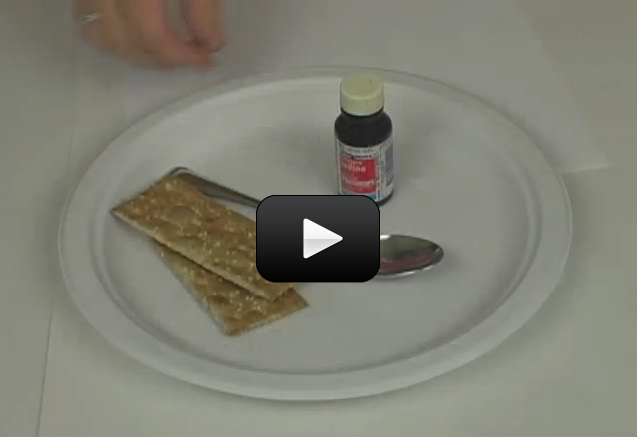Digestion starts in your mouth as soon as you start to chew. Your saliva is full of enzymes. They are a kind of chemical key that unlock chains of protein, fat, and starch molecules. Enzymes break these chains down into smaller molecules like sugars and amino acids.
In this experiment, we will examine how the enzymes in your mouth help to break down the starch in a cracker. You will test the cracker to confirm starch content, then put it in your mouth and chew it for a long time in order to really let the enzymes do their job. Finally you will test the cracker for starch content and see what has happened as a result of your chewing.
[am4show have=’p8;p9;p29;p56;p81;p87;’ guest_error=’Guest error message’ user_error=’User error message’ ]
Here’s what you need
- 1 package of soda crackers
- 1 5” pie tin
- 1 craft stick
- 1 0.5 oz bottle of iodine
- 1 pre-form tube
- 1 1 mL plastic pipette
- water
Download Student Worksheet & Exercises
Here’s what you do
- Take a cracker from the package and put it in the pie tin. Use your thumb to mash it up, making the pieces as small as possible. Add a small amount of water with the pipette. Mix everything up with the craft stick to make a mash of cracker.
- Now fill the pipette with iodine. When iodine comes in contact with starch, it changes in color from reddish-brown to a dark blueish-black. Take the pipette and squeeze a few drops onto the cracker mash in various spots. Record what you see in your experiment data.
- Take another cracker and chew it up for about 2 minutes. Do you notice any flavor changes as you are chewing? If so, note this. Be particularly aware of any sweet flavors.
- Spit the mash into the pre-form tube once you have chewed for 2 minutes. Use the pipette of iodine to add a few drops of iodine to the chewed mash. Note any change in color. If there is no starch, the iodine will stay reddish-brown in color. If starch is present, you will see the color change to a very dark blue-black as it did in step 2. Record what you see in your data.
What’s going on?
This lab gives you a good idea of what happens in digestion, which starts as soon as food enters your mouth. Actually, the process can start even before this as your body prepares for food. Have you ever had a wonderful smell make your mouth water? This is your body’s way of getting ready to get to work digesting that delicious food.
Once you take a bite and the enzymes start to do their job of breaking large, more complex molecules into smaller particles. In this experiment, starch got broken down into simple sugars that your body could easily move around and use as fuel.
There are three sets of saliva-secreting glands in your mouth. They include a gland in the back of your throat called the parotoid gland, one in your lower jaw called the submandibular gland, and the sublingual gland which is under your tongue. The three work together to secrete up to 2 liters of saliva each day.
Exercises
- What is the first step in the digestive process?
- How does saliva help to digest food?
- Name one or more of the main salivary glands and where they are located.
[/am4show]


We first picked the spit testing experiment (chewed up crackers) using iodine to test for starch. At first, we used Lugol’s 2% iodine and both spit samples were not turning blue-black. Then, we used providone-iodine, which is like a 10% solution, but only 1% available iodine. The chewed up cracker turned blue-black with it. Strange. Just shows you how science can give you lots of puzzles to think about.
Thank you for being so passionate about science! It’s inspiring to me as a parent.
Michelle
It should still work – give it a try and let me know how it goes.
Our Iodine is clear in in the bottle. Does this mean it won’t work? Where can we find the orange iodine like in the video?
Thanks
First, make sure your iodine is working right. Put a drop of iodine on a pile of starch (like cornstarch, or cut a potato open and drop iodine on the exposed half). It should change color to dark blue. This is what makes iodine a starch indicator. Next, try chewing for longer… a lot longer than you think. Then have a friend do the same and compare. If that still doesn’t work, try a different cracker!
I followed the directions twice with two different types of starches one was a saltine and the other a noodle.The color of the iodine on the two I chewed up was the same as the color of the iodine on the one that was mixed with water.
Yes, well it is science… sometimes that happens!
the spit sample looked like poop… eww… o_o